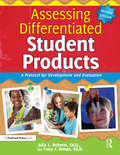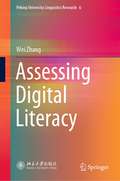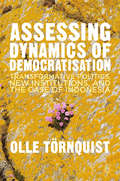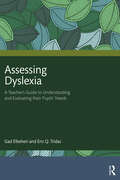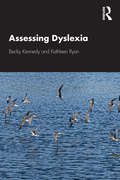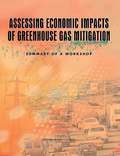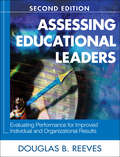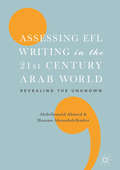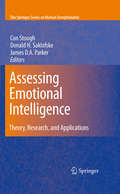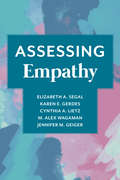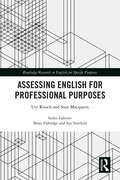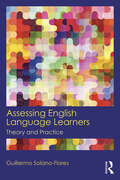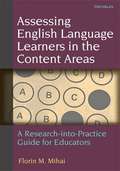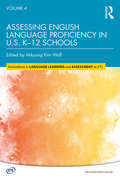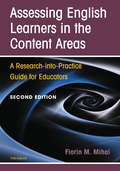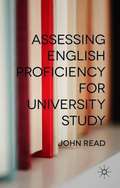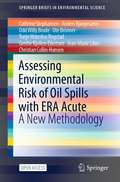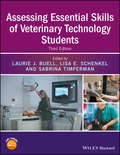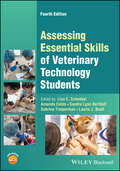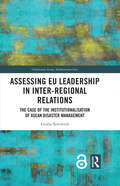- Table View
- List View
Assessing Differentiated Student Products: A Protocol for Development and Evaluation
by Julia L. Roberts Tracy F. InmanThe second edition of Assessing Differentiated Student Products provides educators with tremendous opportunities to differentiate instruction and facilitate continuous progress for every student. This book provides teachers with everything needed to develop and assess products developed by students. The book includes a list of suggested products; more than 100 DAP tools that assess content, presentation, creativity, and reflection at three tier levels using a multilevel performance scale for a variety of products; and detailed information on how to use these tools in the classroom. By encouraging the use of varied products to demonstrate what students have learned, DAP tools engage children, motivate, have real-world connections, require high-level thinking and problem-solving skills, accommodate learning preferences, allow for self-expression and creativity, promote ownership and pride in one's work, and develop lifelong learners.
Assessing Digital Literacy (Peking University Linguistics Research #6)
by Wei ZhangThis book introduces the design and implementation of an assessment model for a new university-level English curriculum in China that aims at developing digital literacy skills. The assessment approach, embedded in the curriculum of an online modular course at Peking University, requires the students to conduct semester-long digital research projects in English in their major fields of study. Combining quantitative and qualitative methods, evaluation rubrics built around Content, Clarity, and Creative/Critical Thinking were developed, evaluated, and refined over three implementation cycles (eight semesters). The book presents a systematic assessment design framework, a set of effective rubrics for evaluating the digital research project, and authentic examples of written and multimedia presentations by Chinese students. Integrating assessment with instruction and technology, the book provides a valuable practical guide to digital literacy assessment for English education in the Outer and Expanding Circle contexts.
Assessing Disorganized Attachment Behaviour in Children: An Evidence-Based Model for Understanding and Supporting Families
by Mel Hamilton-Perry David Shemmings Michelle Thompson David Phillips Yvalia Febrer Henry Smith Alice Cook Yvonne Shemmings Jo George Fran Feeley David Wilkins Claire Denham Sonja Falck Tania YoungAssessing Disorganized Attachment Behaviour in Children lays out an evidence-based model for working with and assessing children with disorganized attachment and their adult carers: families whose extreme, erratic and disturbing behaviour can make them perplexing and frustrating to work with. The model is designed to identify key indicators and explanatory mechanisms of child maltreatment: disorganized attachment in the child, a parent's unresolved loss or trauma, disconnected and extremely insensitive parenting, and low parental mentalisation. The book also outlines ways of assessing children for disorganized attachment and carer capacity, and proposes interventions. Accessible and practical, this book is essential reading for child protection professionals.
Assessing Dynamics Of Democratisation: Transformative Politics, New Institutions, and the Case of Indonesia
by Olle TörnquistThe book summarises the critique of these approaches, suggests a comprehensive alternative framework, and shows how the alternative works in reality through a case study of the largest of the new democracies, Indonesia.
Assessing Dyslexia: A Teacher’s Guide to Understanding and Evaluating their Pupils’ Needs
by Gad Elbeheri Eric Q. TridasIn today’s schools, teachers must screen and monitor for academic difficulties and are expected to use assessments to guide their instruction. Understanding the assessment of students with dyslexia gives teachers the knowledge to identify which skills need remediation, and the students’ strengths that can help them overcome their challenges. Assessing Dyslexia provides teachers with answers to questions they often have about assessment and is applicable not only to students with dyslexia but to all who struggle with reading. Written in accessible terms throughout, this book offers information on understanding and interpreting psychoeducational reports and approaches on how to better communicate with parents and students regarding this process. By demonstrating how to use testing to guide their teaching, this book describes the why, how and what of assessment and promotes the self-sufficiency of teachers by providing them with a clear rationale for why particular instructional strategies should be used. With encouragement for teachers to reflect on assessment critically and resources to expand their skill knowledge, this book provides a clear path to enhancing teachers’ practice and improving their pupils’ attainment. Assessing Dyslexia serves as a suitable reading for all teachers and represents a move from the "wait to fail" model to a test to teach approach, addressing the questions and anxieties of today’s teachers.
Assessing Dyslexia
by Becky Kennedy Kathleen RyanAssessing Dyslexia guides readers through the design, administration, and interpretation of dyslexia assessments. Grounded in research on the linguistic and neural foundations of dyslexia, as well as the clinical outcomes of reading and writing processes, this concise volume provides a comprehensive framework for assessment, diagnosis, and intervention. Utilizing detailed examples to illustrate methodology and concepts, this book is critical reading for students looking to deepen their understanding of assessment, literacy, and the written language challenge.
Assessing Early Warning Systems: How Have They Worked in Practice?
by Andrew Berg Eduardo Borensztein Catherine PattilloA report from the International Monetary Fund.
Assessing Economic Impacts of Greenhouse Gas Mitigation: Summary of a Workshop
by National Research Council of the National AcademiesMany economic models exist to estimate the cost and effectiveness of different policies for reducing greenhouse gas (GHG) emissions. Some approaches incorporate rich technological detail, others emphasize the aggregate behavior of the economy and energy system, and some focus on impacts for specific sectors. Understandably, different approaches may be better positioned to provide particular types of information and may yield differing results, at times rendering decisions on future climate change emissions and research and development (R&D) policy difficult. Reliable estimates of the costs and benefits to the U.S. economy for various emissions reduction and adaptation strategies are critical to federal climate change R&D portfolio planning and investment decisions. At the request of the U.S. Department of Energy (DOE), the National Academies organized a workshop to consider these issues. The workshop, summarized in this volume, comprised three dimensions: policy, analysis, and economics. Discussions along these dimensions were meant to lead to constructive identification of gaps and opportunities. The workshop focused on (1) policymakers' informational needs; (2) models and other analytic approaches to meet these needs; (3) important economic considerations, including equity and discounting; and (4) opportunities to enhance analytical capabilities and better inform policy.
Assessing Educational Leaders: Evaluating Performance for Improved Individual and Organizational Results
by Douglas B. ReevesFeaturing real-world examples, this revised bestseller shows you how to improve educational leadership and organizational performance through a multidimensional leadership assessment system.
Assessing EFL Writing in the 21st Century Arab World: Revealing the Unknown
by Abdelhamid Ahmed Hassan AbouabdelkaderThis book empirically explores assessment of EFL (English as a Foreign Language) writing in different Arab world contexts at the university level, which often presents a challenge for teachers and students alike. Analysing a number of different practices throughout the chapters including peer assessment, self-assessment, e-rubrics and writing coherence, the authors highlight different issues and challenges that affect the assessment of EFL writing in the Arab world, and provide valuable insights into how it can be improved. This book is sure to become an important practical resource for practitioners, researchers, professors and graduate students working on EFL writing in this region.
Assessing Emotional Intelligence: Theory, Research, and Applications (The Springer Series on Human Exceptionality)
by James D. Parker Donald H. Saklofske Con StoughManaging human emotions plays a critical role in everyday functioning. After years of lively debate on the significance and validity of its construct, emotional intelligence (EI) has generated a robust body of theories, research studies, and measures. Assessing Emotional Intelligence: Theory, Research, and Applications strengthens this theoretical and evidence base by addressing the most recent advances and emerging possibilities in EI assessment, research, and applications. This volume demonstrates the study and application of EI across disciplines, ranging from psychometrics and neurobiology to education and industry. Assessing Emotional Intelligence carefully critiques the key measurement issues in EI, and leading experts present EI as eminently practical and thoroughly contemporary as they offer the latest findings on: EI instruments, including the EQ-I, MSCEIT, TEIQue, Genos Emotional Intelligence Inventory, and the Assessing Emotions Scale. The role of EI across clinical disorders. Training professionals and staff to apply EI in the workplace. Relationships between EI and educational outcomes. Uses of EI in sports psychology. The cross-cultural relevance of EI. As the contributors to this volume in the Springer Series on Human Exceptionality make clear, these insights and methods hold rich potential for professionals in such fields as social and personality psychology, industrial and organizational psychology, psychiatry, business, and education.
Assessing Empathy
by Elizabeth Segal Karen Gerdes Cynthia Lietz M. Alex Wagaman Jennifer GeigerEmpathy is a widely used term, but it is also difficult to define. In recent years, the field of cognitive neuroscience has made impressive strides in identifying neural networks in the brain related to or triggered by empathy. Still, what exactly do we mean when we say that someone has—or lacks—empathy? How is empathy distinguished from sympathy or pity? And is society truly suffering from an "empathy deficit," as some experts have charged??In Assessing Empathy, Elizabeth A. Segal and colleagues marshal years of research to present a comprehensive definition of empathy, one that links neuroscientific evidence to human service practice. The book begins with a discussion of our current understanding of empathy in neurological, biological, and behavioral terms. The authors explain why empathy is important on both the individual and societal levels. They then introduce the concepts of interpersonal empathy and social empathy, and how these processes can interrelate or operate separately. Finally, they examine the weaknesses of extant empathy assessments before introducing three new, validated measures: the Empathy Assessment Index, the Social Empathy Index, and the Interpersonal and Social Empathy Index.
Assessing English for Professional Purposes (Routledge Research in English for Specific Purposes)
by Ute Knoch Susy MacqueenAssessing English for Professional Purposes provides a state-of-the-art account of the various kinds of language assessments used to determine people’s abilities to function linguistically in the workplace. At a time when professional expertise is increasingly mobile and diverse, with highly trained professionals migrating across national boundaries to apply their skills in English-speaking settings, this book offers a renewed agenda for inquiry into language assessments for professional purposes (LAPP). Many of these experts work in high-risk environments where communication breakdowns can have serious consequences. This risk has been identified by governments and professional bodies, who implement language tests for gate-keeping purposes. Through a sociological lens of risk and responsibility, this book: provides a detailed overview of both foundational and recent literature in the field; offers conceptual tools for specific purpose assessment, including a socially oriented theory of construct; develops theory and practice in key areas, such as needs analysis, test development, validation and policy; significantly broadens the scope of the assessment of English for professional purposes to include a range of assessment practices for both professionals and laypeople in professional settings. Assessing English for Professional Purposes is key reading for researchers, graduate students and practitioners working in the area of English for Specific Purposes assessment.
Assessing English Language Learners: Theory and Practice
by Guillermo Solano FloresAssessing English Language Learners explains and illustrates the main ideas underlying assessment as an activity intimately linked to instruction and the basic principles for developing, using, selecting, and adapting assessment instruments and strategies to assess content knowledge in English language learners (ELLs). Sensitive to the professional development needs of both in-service and pre-service mainstream teachers with ELLs in their classrooms and those receiving formal training to teach culturally and linguistically diverse students, the text is designed to engage readers in viewing assessment as a critical part of teaching appreciating that assessments provide teachers with valuable information about their students’ learning and thinking becoming aware of the relationship among language, culture, and testing understanding the reasoning that guides test construction recognizing the limitations of testing practices being confident that assessment is an activity classroom teachers (not only accountability specialists) can perform Highlighting alternative, multidisciplinary approaches that address linguistic and cultural diversity in testing, this text, enhanced by multiple field-tested exercises and examples of different forms of assessment, is ideal for any course covering the theory and practice of ELL assessment.
Assessing English Language Learners: Connecting Academic Language Proficiency to Student Achievement
by Dr Margo GottliebBuild the bridges for English language learners to reach success! This thoroughly updated edition of Gottlieb’s classic delivers a complete set of tools, techniques, and ideas for planning and implementing instructional assessment of ELLs. The book includes: A focus on academic language use in every discipline, from mathematics to social studies, within and across language domains Emphasis on linguistically and culturally responsive assessment as a key driver for measuring academic achievement A reconceptualization of assessment “as,” “for,” and “of” learning Reflection questions to stimulate discussion around how students, teachers, and administrators can all have a voice in decision making
Assessing English Language Learners: Connecting Academic Language Proficiency to Student Achievement
by Dr Margo GottliebBuild the bridges for English language learners to reach success! This thoroughly updated edition of Gottlieb’s classic delivers a complete set of tools, techniques, and ideas for planning and implementing instructional assessment of ELLs. The book includes: A focus on academic language use in every discipline, from mathematics to social studies, within and across language domains Emphasis on linguistically and culturally responsive assessment as a key driver for measuring academic achievement A reconceptualization of assessment “as,” “for,” and “of” learning Reflection questions to stimulate discussion around how students, teachers, and administrators can all have a voice in decision making
Assessing English Language Learners In The Content Areas: A Research-into-practice Guide For Educators
by Florin MihaiAssessing English Language Learners in the Content Areas: A Research-into-Practice Guide for Educators seeks to provide guidance to classroom teachers, staff developers, and test-item designers who want to improve ELL assessment outcomes, particularly in the areas of math, science and social studies. The first two chapters of the book establish the background for the discussion of content-area assessment for ELLs, examining several important characteristics of this rapidly growing student population (as well as critical legislation affecting ELLs) and providing a description of various forms of assessment, including how ELL assessment is different from the assessment of English-proficient students Important assessment principles that educators should use in their evaluation of tests or other forms of measurement are provided. Other chapters review ELL test accommodations nationwide (because, surprisingly, most teachers do not know what they can and cannot allow) and the research on the effectiveness of these types of accommodations. The book analyzes the characteristics of alternative assessment; it discusses three popular alternative assessment instruments (performance assessment, curriculum-based measurement, and portfolios) and makes recommendations as to how to increase the validity, reliability, and practicality of alternative assessments. The book proposes fundamental assessment practices to help content area teachers in their evaluation of their ELL progress.
Assessing English Language Proficiency in U.S. K–12 Schools
by Mikyung Kim WolfAssessing English Language Proficiency in U.S. K–12 Schools offers comprehensive background information about the generation of standards-based, English language proficiency (ELP) assessments used in U.S. K–12 school settings. The chapters in this book address a variety of key issues involved in the development and use of those assessments: defining an ELP construct driven by new academic content and ELP standards, using technology for K–12 ELP assessments, addressing the needs of various English learner (EL) students taking the assessments, connecting assessment with teaching and learning, and substantiating validity claims. Each chapter also contains suggestions for future research that will contribute to the next generation of K–12 ELP assessments and improve policies and practices in the use of the assessments. This book is intended to be a useful resource for researchers, graduate students, test developers, practitioners, and policymakers who are interested in learning more about large-scale, standards-based ELP assessments for K–12 EL students.
Assessing English Learners in the Content Areas, Second Edition: A Research-into-Practice Guide for Educators
by Florin MihaiAssessing English Learners in the Content Areas, Second Edition: A Research-into-Practice Guide for Educators
Assessing English Proficiency for University Study
by John ReadThis book focuses on strategies and procedures for assessing the academic language ability of students entering an English-medium university, so that those with significant needs can have access to opportunities to enhance their language skills.
Assessing Environmental Risk of Oil Spills with ERA Acute: A New Methodology (SpringerBriefs in Environmental Science)
by Cathrine Stephansen Anders Bjørgesæter Odd Willy Brude Ute Brönner Tonje Waterloo Rogstad Grethe Kjeilen-Eilertsen Jean-Marie Libre Christian Collin-HansenThis open access book introduces readers to a new methodology for assessing the risks to the marine environment following accidental oil spills. The methodology will soon be implemented on the Norwegian Continental Shelf and will be complemented by guidelines for its use in a regulatory framework. The brief book is intended to provide international readers with a basic grasp of what the ERA Acute methodology consists of, what its applications are, and the underlying impact and restoration models used in its development. The content is divided into three main parts: an introduction and overview of risk management applications for generalists at the management level, a model overview for generalist scientists, and a more detailed final section for risk assessment professionals, which presents the results of the validation and sensitivity testing.
Assessing Equity in the Distribution of Fisheries Management Benefits: Data And Information Availability
by National Academies of Sciences, Engineering, and Medicine Division on Earth and Life Studies Ocean Studies Board Committee on Assessing Equity in the Distribution of Fisheries Management Benefits: Data and Information AvailabilityFisheries are essential to the global economy and feed billions around the world; they, support individuals and communities, and sustain cultural heritages and livelihoods. Although U.S. fisheries have been managed for commercial fishing historically, there has been an interest more recently in better accounting for and meeting the needs of the diverse individuals, groups, and communities that rely on and participate in fisheries, or aspire to do so. At the request of the National Marine Fisheries Service, this report considers information needs and data collection for assessing the distribution of fisheries management benefits. Assessing Equity in the Distribution of Fisheries Management Benefits identifies information needs, obstacles to collecting information, and potential methodologies for assessing where and to whom the primary benefits of commercial and for-hire fishery management accrue.
Assessing Essential Skills of Veterinary Technology Students
by Laurie J. Buell Lisa E. Schenkel Sabrina TimpermanAssessing Essential Skills of Veterinary Technology Students, Third Edition provides students and instructors with clear guidance on how to evaluate student performance of skills required to enter the veterinary technology profession. Provides students with clear guidance on the capabilities they are expected to demonstrate and how they will be evaluated Gives instructors a standardized framework for assessing students’ performance Offers tools for comparing standards of competency Covers management, pharmacology, medical nursing, anesthesia and analgesia, surgical nursing, laboratory procedures, radiography, laboratory animal care, and exotic animal nursing Includes access to a companion website with a downloadable log for recording progress
Assessing Essential Skills of Veterinary Technology Students
by Laurie J. Buell Lisa E. Schenkel Sabrina Timperman Amanda Colón Sandra Lynn BertholfStandardized assessment criteria covering all essential skills from the nine areas required by the American Veterinary Medical Association Committee on Veterinary Technician Education and Activities The newly revised and updated Fourth Edition of Assessing Essential Skills of Veterinary Technology Students provides a comprehensive review of the required American Veterinary Medical Association Committee on Veterinary Technician Education and Activities (AVMA CVTEA®) essential skills for completion of a veterinary technology degree. Each essential skill includes assessment criteria as well as decision-making instructions necessary to demonstrate proficiency both academically and professionally. The text is organized based on the categories provided by the AVMA CVTEA, making it easy for an instructor and students to locate the assessment criteria for a particular essential skill relative to their course. Several guidelines from veterinary organizations regarding standard of care in veterinary medicine have been updated since the publication of the previous edition, including 2018 A AHA Infection Control, Prevention and Biosecurity Guidelines, 2022 AAHA Pain Management Guidelines for Dogs and Cats, 2021 AAHA/AAFP Feline Life Stages Guidelines, 2019 AAHA Canine Life Stages Guidelines, 2021 AAHA Nutrition and Weight Management Guidelines, 2023 AAHA Technician Utilization Guidelines, and others. Written by highly qualified authors, Assessing Essential Skills of Veterinary Technology Students includes assessment criteria that addresses the knowledge, decision-making capabilities, and hands-on skills for the following: Pharmacologic fundamentals of drug administration, pharmacy essentials of drug dispensing, compliance with state and federal regulation, and monitoring of therapeutic responses.Ethics, jurisprudence, and communication in veterinary management.Husbandry, nutrition, and therapeutics of common domestic species, handling and restraint, patient assessment, and dental procedures in small animals.Fundamentals of and experiences with common surgical procedures, patient management and use of anesthetic equipment, proper surgical assistance, pain management, management of surgical equipment and facilities, and perioperative management.Diagnostic laboratory procedures and management of laboratory specimens and equipment, parasitology of common domestic species and diagnostic procedures for parasite, microbiologic procedure and evaluations and necropsy procedures.Avian, exotic, small, and large animal husbandry and nursing skills. The Fourth Edition of Assessing Essential Skills of Veterinary Technology Students is an essential study resource for all undergraduate students enrolled in an AVMA CVTEA accredited veterinary technology program and an excellent teaching resource for instructors of veterinary technology courses.
Assessing EU Leadership in Inter-regional Relations: The Case of the Institutionalisation of ASEAN Disaster Management (Globalisation, Europe, and Multilateralism)
by Giulia TercovichThis book comparatively analyses the role of the EU in influencing the policies of other regional organisations by assessing its role in leading the institutionalisation of ASEAN disaster management institutions. By exploring the role of actors as drivers of the process that led to the institutionalisation of the ASEAN disaster response mechanism, it unpacks the process and assesses the role of the EU in directly or indirectly leading this process, whilst including the role played by other relevant actors, namely Australia, New Zealand, Japan, USA and the UN. In doing so, the book proposes an original framework going beyond the idea of the EU as a sui generis actor and adds a comparative dimension to the analysis of the EU's influence on regional processes. This book will be of key interest to scholars, students and practitioners of EU External Relations, Security Studies, Regional Studies, disaster management, ASEAN-EU relations, EU actorness, and more broadly to and Asia Studies, international relations and inter-regionalism.
